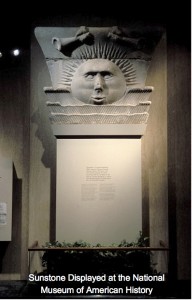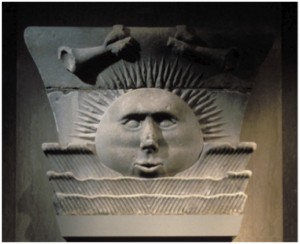Some Questions to Consider when Displaying Religious Artifacts
The displaying of an artifact, in this case a religious artifact, raises complex questions. For example, should the artifact be displayed? Who has the right to display the artifact? How will the displaying of the artifact be presented and for whose purpose? How much religious belief should be explained when an artifact is displayed? Is the religious integrity of the artifact maintained or should it be maintained? These questions should be considered as one seeks to discuss“the role of artifacts in conveying the history of religion at museums and at historic sites.”
 To illustrate, the Smithsonian’s National Museum of American History (“Museum”) displays one of only two extant sunstones from the original Nauvoo Temple of the Church of Jesus Christ of Latter-day Saints.This sunstone was part of the outside of the Nauvoo Temple which was completed in1845.The temple was burned in a fire in1848 and later destroyed by a tornado.[1]
To illustrate, the Smithsonian’s National Museum of American History (“Museum”) displays one of only two extant sunstones from the original Nauvoo Temple of the Church of Jesus Christ of Latter-day Saints.This sunstone was part of the outside of the Nauvoo Temple which was completed in1845.The temple was burned in a fire in1848 and later destroyed by a tornado.[1]
In 1989, the Museum acquired the sunstone from the Historical Society of Quincy and Adams Counties in Illinois for $100,000.The acquisition was one of the largest expenditures the museum has ever made.
When the sunstone was acquired, Richard Ahlborn, curator at the Museum, stated that“the stone is symbolic of the most persistent religious movement in American History.” He added that the museum sought the sunstone because“it is a central symbol of the heroic effort by the Mormon pioneers in their movement from upstate New York to Utah to maintain their belief system.”[2] 2
The views ascribed to the sunstone by the Museum in 1989 continue today as shown by the Museum’s American Stories website.The website states that “objects and stories both reinforce and challenge our understanding of American history and help define our personal and cultural identities.”The website then invites us“on a journey through time to discover what we can learn through artifacts.”[3]One of the artifacts in the Expansion and Reform period of the website is the sunstone.
The website displays the sunstone as shown below:
 “about 1846 from the temple of the Latter-day Saints in Nauvoo, Illinois
“about 1846 from the temple of the Latter-day Saints in Nauvoo, Illinois
Joseph Smith published the Book of Mormon in 1830,during agreat Christian revivalist movement. Persecuted from the beginning, the Latter-day Saints left New York State and went west in search of sanctuary. Nauvoo was just one step along the way of a migration toward what became Salt Lake City, Utah; it drew tens of thousands of converts from the eastern United States and many European countries.”[4]
True to the original intent of its purchase, the Museum displays the sunstone in an effort to explain one group’s role in the westward expansion of the country and a religion’s struggle for survival. Although the Museum’s presentation is professional and sympathetic to the Mormon plight, the actual symbolism of the sunstone and role within the religion’s faith is absent from the presentation. As such, the sunstone’s original purpose as reflected in its symbols and as part of the temple is lost to the observer. This loss of meaning is one of the main reasons the questions outlined at the beginning of this paper should be addressed when determining the role of religious artifacts displayed at museums and at historic sites.[1] “The Nauvoo Temple and Rebirth”
[2] Davidson, Lee, “Nauvoo Sunstone at Smithsonian,” Deseret News, November 28, 1989
[3] American Stories website
[4] “Sunstone Capital”
[5] Photo source: LDS media library




![Sunstone on the rebuilt Nauvoo Temple [5]](https://ncph.org/wp-content/uploads/2015/03/stover31-300x200.jpg)
Thanks for this, Jeff. When I read the part about the stop at Nauvoo being just one step in a westward migration, it certainly made me think that such an interpretation misses the nuance that nearly all of the stops Latter-day Saints made (certainly in Missouri and in Nauvoo) were not meant to just be temporary before they went west. They were meant to be places where they would build up Zion in order to usher in Christ’s Second Coming–which is why the construction of temples was deemed essential in these areas. Failing to convey that seems to miss a large part of the significance of the sunstone.
That comment brings up what confused me about the sunstone: why build such monumental architecture if you were on some inevitable path to Utah? Even such a brief label as is provided on the website could be tweaked to provide better context for the way Western expansion was voluntary for every group that moved West.
*was NOT voluntary.